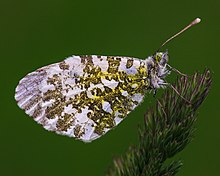Aurora butterfly
| Aurora butterfly | ||||||||||||
|---|---|---|---|---|---|---|---|---|---|---|---|---|

Aurora butterfly ( Anthocharis cardamines ) (male) |
||||||||||||
| Systematics | ||||||||||||
|
||||||||||||
| Scientific name | ||||||||||||
| Anthocharis cardamines | ||||||||||||
| ( Linnaeus , 1758) |
The aurora butterfly ( Anthocharis cardamines ) is a butterfly (day butterfly ) from the family of white flies (Pieridae). The species name is derived from the plant species of the genus Cardamine ( foam herbs ), the leaves of which are food for the caterpillars .
features
The moths reach a wingspan of 35 to 45 millimeters. The wings of both sexes are white, with the outermost tip of the forewings gray to gray-black in color and a small black point in the middle of these wings. The outer half of the forewings of the males is strikingly orange in color. Since the female lacks the orange color, it is easy to confuse them with other types of white flies (Pieridae). The distinction is then made on the basis of the underside of the hind wings, which in both sexes has an irregular yellowish, dirty green and white markings. In the male, the orange color of the upper side of the forewing can also be seen on the lower side.
The caterpillars are about 30 millimeters long. The blue-green upper side merges into white on the sides of the body. They are dark green on the underside. If the caterpillar sits down on the back of the forage plant as usual, e.g. B. on the still green pods, then there is a lightening of the body shadow and thus requires a kind of camouflage : the principle of counter-shading.
Similar species
The males are distinctive, but the females can be confused with several species:
- Reseda butterfly ( Pontia edusa )
- Pontia daplidice
- Matt-spotted whiteling ( Euchloe simplonia )
- Eastern aurora butterfly ( Anthocharis damone )
- Yellow aurora butterfly ( Anthocharis euphenoides )
Subspecies
- Anthocharis cardamines progressa (Sovinsky 1905)
- Anthocharis cardamines septentionalis (Wnukowsky, 1927)
- Anthocharis cardamines phoenissa (from Kalchberg, 1894)
- Anthocharis cardamines (Hemming, 1933)
- Anthocharis cardamines koreana ( Matsumura , 1925)
- Anthocharis cardamines kobayashii (Matsumura, 1925)
- Anthocharis cardamines isshikii (Matsumura, 1925)
- Anthocharis cardamines hayashii (Fujioka, 1970)
Occurrence
The aurora butterflies are widespread across Europe and the Middle East . In Asia they occur in temperate climates to Japan . They live on lean and dry meadow areas or on wet meadows , as well as in light and humid forests . They are common almost everywhere.
Way of life
In May the female attaches one egg, rarely several, to the flower stalks of the caterpillar forage plants. The spindle-shaped egg is initially white, later orange. After a few days, the caterpillars hatch in order to prefer to feed on the flowers and pods of the cruciferous vegetables. They are strict loners and avoid the company of their own kind. The caterpillars are difficult to spot because of their color. After about five weeks, the feeding and growth phase is complete. The caterpillar is now looking for a suitable support near the ground, usually on the plant stem near the food plant. There it pupates into a soon gray-brown or green belt-shaped doll . This looks woody, is narrow and has a sickle-shaped, extended head end that makes it appear like a plant thorn. The pupa overwinters, the moth hatches after ten months of dormancy in the first warm period in the following year.
The preferred host plants of the aurora butterfly are the meadow foam herb ( Cardamine pratensis ) and the garlic mustard ( Alliaria petiolata ). Other food plants are cruciferous species (Brassicaceae), such as annual silver leaf ( Lunaria annua ) or common night viola ( Hesperis matronalis ).
Flight and caterpillar times
The caterpillars can be found from May to the beginning of July, and even later at higher altitudes. The adults fly from early April to June, in warm areas from late March to late May. At higher altitudes, the flight time does not begin until mid or late April; there the moths can be found until July.
Belt doll of the aurora butterfly
swell
Individual evidence
- ^ Arnold Spuler: The butterflies of Europe . tape 1 . E. Schweitzerbartsche Verlagbuchhandlung, Stuttgart 1908, p. 8 .
- ↑ a b c Heiko Bellmann : The new Kosmos butterfly guide. Butterflies, caterpillars and forage plants. Franckh-Kosmos, Stuttgart 2003, ISBN 3-440-09330-1 , p. 122.
- ↑ a b c W. Düring: Aurorafalter. In: Species portraits of butterflies in Rhineland-Palatinate. BUND RLP, March 26, 2020, accessed on March 27, 2020 (German).
- ↑ Anthocharis cardamines. Butterflies-Deutschlands.de, Christian Tolasch, accessed on November 23, 2006 .
literature
- Tom Tolman, Richard Lewington: The butterflies of Europe and Northwest Africa. Franckh-Kosmos Verlags-GmbH & Co, Stuttgart 1998, ISBN 3-440-07573-7 .
- Hans-Josef Weidemann: Butterflies: observe, determine. Naturbuch-Verlag Augsburg 1995, ISBN 3-89440-115-X .
- Günter Ebert, Erwin Rennwald: The butterflies of Baden-Württemberg. Volume 1, Tagfalter I. Ulmer Verlag Stuttgart 1993, ISBN 3-8001-3451-9 .
Web links
- Lepiforum e. V. Taxonomy and Photos
- www.schmetterling-raupe.de
- Species portraits of butterflies in Rhineland-Palatinate - Aurora butterflies
- www.eurobutterflies.com (English)
- Moths and Butterflies of Europe and North Africa (English)
- Natural history information system
- Anthocharis cardamines in Fauna Europaea









